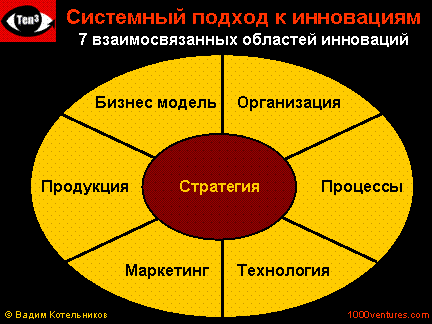|
Innovation Bringing New Ideas to Life |
|
by Vadim Kotelnikov, Founder, The first-ever Ten3 Business e-Coach for Innovative Leaders, 1000ventures.com
"One machine can do the work of fifty ordinary men. No machine can do the work of one extraordinary man." - Elber Hubbard
|
Innovation Defined Innovation is a process of taking new ideas through to satisfied customers. It is the conversion of new knowledge into new products and services. Innovation is about creating value and increasing productivity, and therefore growing your business. It is a spark that keeps organizations and people moving ever onward and upward. "Without innovation, new products, new services, and new ways of doing business would never emerge, and most organizations would be forever stuck doing the same old things the same old way."4 Technological Innovation Alone Is Not Enough Facing a tidal wave of global economic, technological and social change, you are not going to survive in the new rapidly globalizing economy through technological innovation alone. If you are going to withstand relentless global competition, you need to radically change the way of doing business. Renewed Emphasis on Innovation Shift to the new knowledge-based economy, combined with a dramatic increase in highly capable global competition, demands a renewed emphasis on innovation. Rapid changes in the competitive environment create the new world of competition - "a fierce contest set in truly global context, with more capable players, higher stakes, and vastly different rules of engagement from those that we have enjoyed to date."3 This new economy is led by those who innovate - create, find and/or combine knowledge into new products, services, and distribution methods - faster than their competitors. Innovation is above all spurred by entrepreneurial action, aimed at creating value through the application of knowledge. Innovation: A Paradigm Shift Innovation is bringing a paradigm shift in the way the business is done in a rapidly globalizing economy. This new economy is characterized by enhanced frequency of innovations, shortening of product, technology, and economic life cycles, rapid generation and commercialization of new technologies, globalization not only large but also small businesses, enhanced emphasis on business partnerships and strategic alliances, intensive and multi-country research and development programs and difficulty in accessing critical technologies. Different Forms of Innovation Until recently innovation has been seen as the means to turn research results into commercially successful products or services. Today, while research keeps playing its critical role as a major contributor to innovation, many new forms of innovation have emerged. They include system's approach to integration of new technologies and processes from other fields, new business models and ways of doing business, and new ways of reaching and servicing customers. Innovation can have different:
New Systemic Approach to Innovation Until recently innovation has been seen principally as the means to turn research results into commercially successful products, but not all research leads to innovation and not all innovation is research-based. Certainly research is a major contributor to innovation, generating a flow of technical ideas and continually renewing the pool of technical skills. It should be a vital ingredient in your enterprise strategy, particularly over long term, if you are to maintain a stream of competitive products on the market.2 Important though research is as the source of invention, innovation encompasses more than the successful application of research results. Innovation can also stem from adopting new technologies or processes from other fields, or from new ways of doing business, or from new ways of marketing products and services. The evolution of the innovation concept - from the linear model having R&D as the starting point to the systemic model in which innovation arises from complex interactions between individuals, organizations and their operating environments - demonstrates that your innovation policies and practices must extend their focus beyond the link with research2...More Business Innovation Business innovation involves a wide spectrum of original concepts, including development of new business models, organizational innovation, business application of technology and communications, new management techniques, environmental efficiency, new forms of stakeholder participation, transport and finance. Strategy Innovation "Strategy innovation is about challenging existing industry methods of creating customer value in order to meet newly emerging customer needs, add additional value, and create new markets and new customer groups for the sponsoring company."1 It is to help a company develop new value added services, enter new markets, create new market segments/categories, new distribution methods, and new forms of customer service and customer partnership. Product / Service Innovation Product/service innovation is the result of bringing to life a new way to solve the customer's problem - through a new product or service development - that benefits both the customer and the sponsoring company.1 Process Innovation Process innovations increase bottom-line profitability, reduce costs, improve efficiency, raise productivity, and increase employee job satisfaction. They also delivers enhanced product or service value to the customer. For manufacturing companies, process innovation include such things as integrating new production methods and technologies that lead to improved efficiency, quality, or time-to-market, and services that are sold with those products. For service companies, process innovations enable them to introduce "front office" customer service improvements and add new services. Technology Innovation Technological innovation covers innovation derived from research and technology developments that are independent of product and service initiative. "The best companies maintain roadmaps that define the next technologies they will pursue and the requisite timing of each. These technology roadmaps are matched to their product roadmaps to ensure that the two are synchronized."3 As core technology developments take longer than shorter product and service initiatives, by separating research and invention from product and service development, companies can achieve stretch without incurring too much risk. Organizational Innovation Organizational innovation reflects the recognition that new ways of organizing work in areas such as work-force management (such as employee empowerment, new people partnership, or positive action to involve all employees in order to make work organization a collective resource for innovation), knowledge management, value chain management, customer partnership, distribution, finance, manufacturing, etc. can improve your competitiveness. Organizational innovation also include business model innovation...More Presentational Innovation Organizational innovation is a comprehensive term that covers innovation in areas such as design and marketing. Entrepreneurial Action - the Engine of Innovation While research and invention is a major contributor to innovation, if there is no entrepreneurial action there is no value creation. Innovation as an Engine of Economic Growth The speed and efficiency of the diffusion of innovation through the economy is critical to productivity and economic growth. It can be pictured as a cascade process. Through the forces of competition and imitation, an initial innovation is developed and improved so that the impact on the economy is many times greater than that brought about by the first application of the innovation.2 Leaders in technology development are not necessarily leaders in technology adoption. The most important economic contribution does not necessarily come from the "early adopter" but from the "fast follower" who adopts the innovative design that captures the international market.2 As Jack Welch, former CEO of General Electric, puts it:" The operative assumption today is that someone, somewhere, has a better idea; and the operative compulsion is to find out who has that better idea, learn it and put into action - fast." In fast-moving sectors it is the new enterprises with growth potential that are often the most innovative, forcing established enterprises to respond to the change by themselves becoming more innovative. Encouraging the emergence of new firms is a strong force for innovation in many sectors.2 Case in Point: IDEO Tom Peters, one of the world's greatest management gurus, says, "In recent years, as the L.O.I. (Legend of IDEO) has spread far and wide, the company has had clients begging for advice not just on a product or two, but on the IDEO way of innovating. It has responded vigorously." Their "methodology not only works for IDEO, but has proven to be transferable. It's now quite simple, of course. Beneath the IDEO method lies the incredible, throbbing IDEO spirit that led me to love at first sight."8...More
|
Bibliography:
-
"Driving Growth Through Innovation", Robert B. Tucker, 2002
-
"Communication on Innovation Policy", European Commission, March 2003
-
"Relentless Growth", Christopher Meyer, 1998
-
"1001 Ways to Take Initiative", Bob Nelson, 1999
-
"Effective Innovation", John Adair, 1996
-
"Making a Difference", Bruce Nixon, 2001
-
"The Art of Innovation", Tom Kelley, 2001
-
Tom Peters, Foreword for the "The Art of Innovation", Tom Kelley, 2001



